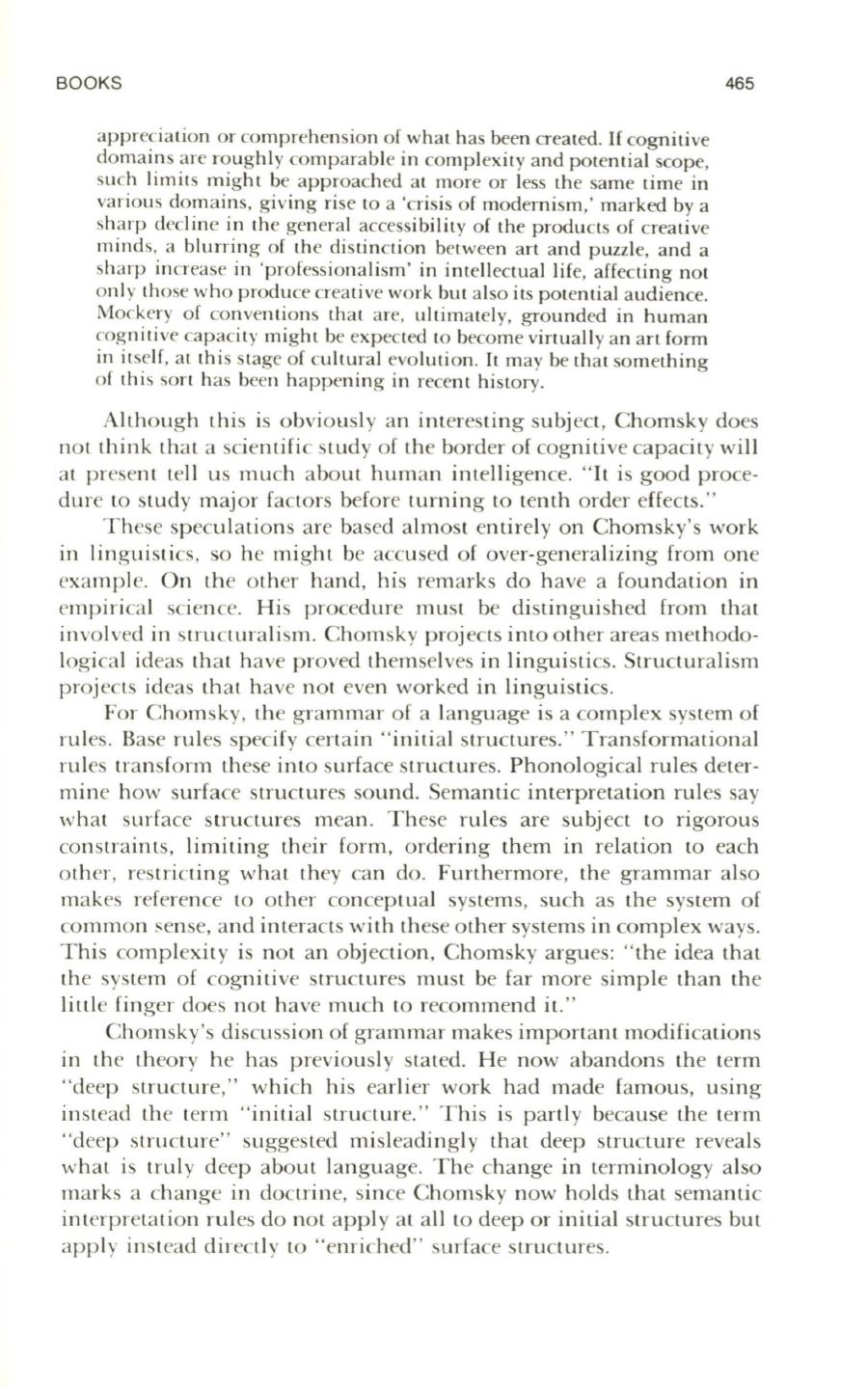
BOOKS
apprecia tion or comprehension of what has been created.
If
cognitive
doma ins are roughl y comparable in compl exity and potential scope,
such limits might be approached at more or less the same time in
va rious doma ins, giving ri se to a 'crisi s of modernism,' marked by a
sha rp decline in the general accessibility of the products of creative
mind s, a blurring of th e di stincti on between art and puzzle, and a
sharp increase in 'pro fess ionalism ' in intellectua l life, affecting not
onl y th ose who produce creative work but also its potenti al audience.
Mockery of conventions tha t are, ultimately, grounded in human
cogniti ve cap acity mi ght be expected to become virtuall y an art form
in itself, at thi s stage of cultural evo luti on.
It
may be tha t something
o f thi s son h as been hap pening in recent history.
465
Although thi s is obvio usly an interesting subj ect, Chomsky does
no t think tha t a scientifi c study of the border of cognitive capacity will
at present tell us much a bout human intelligence.
" It
is good p roce–
dure to study major factors before turning to tenth order effects."
T hese speculati ons a re based almos t entirely on Chomsky's work
in lin gui sti cs, so he mi ght be accused of over-generalizing from one
exampl e. On th e o ther h and, hi s remarks do have a founda ti on in
emp iri ca l scien ce. His procedure must be di stingui shed from tha t
in vo lved in stru ctura li sm . Chomsky proj ects into other areas methodo–
logica l ideas th a t have proved themselves in lingui sti cs. Structurali sm
p rojects ideas tha t have n ot even worked in linguistics .
For Chomsky, the gramma r of a langu age is a compl ex sys tem o f
rul es . Base rul es spec ify certa in " initi al structures." Transfo rma ti onal
rul es transfo rm these into surface structures. Phono logical rul es deter–
mine how surface structures sound. Semantic interpretation rul es say
wha t surface structures mean . These rul es are subj ect to rigorous
constra ints, limiting their form, ordering them in relation to each
o th er, res tri ctin g wha t they can do. Furthermore, the grammar also
ma kes reference to other conceptual sys tems, such as the sys tem of
common
~en se,
and interacts with these o ther sys tems in compl ex ways.
T hi s compl exit y is no t an obj ecti on , Chomsky argues: " the idea th at
th e sys tem o f cognitive structures must be far more simple than the
lillie fin ger does not have much to recommend it. "
Chomsky's discussion of gramma r makes important modifi cati ons
in the theory h e has previ o usly sta ted. He now abandons the term
"deep structure," which hi s earlier work had made famous, using
in stead the term " initial structure." This is partl y because the term
"deep structure" sugges ted mi sleadingly that deep structure reveals
wha t is trul y deep about langu age. The change in terminology also
ma rks a ch ange in doctrine, since Chomsky now holds tha t semantic
interp reta ti on rul es do no t appl y a t all to deep or initial structures but
app ly in stead directl y to "enri ched" surface structures.


